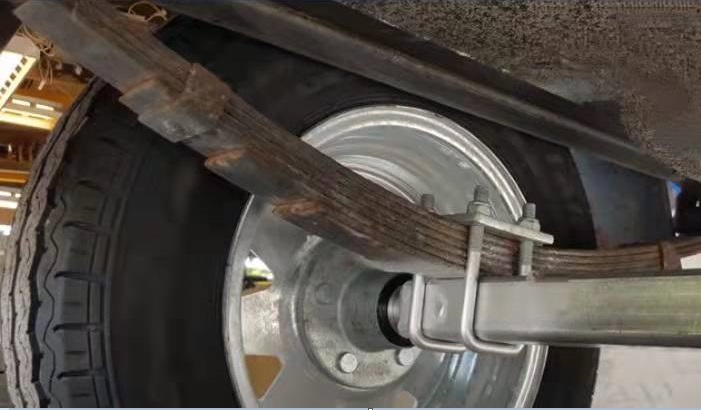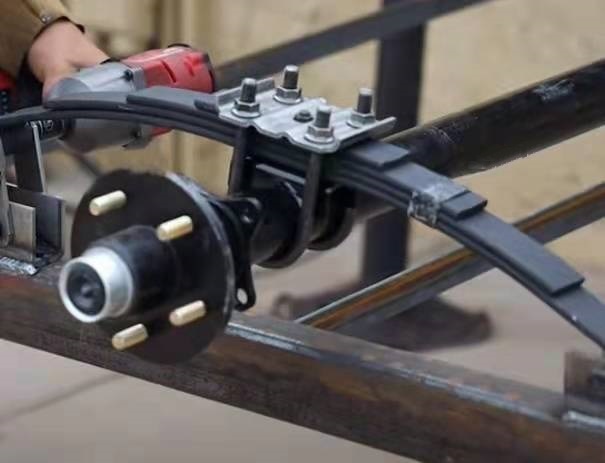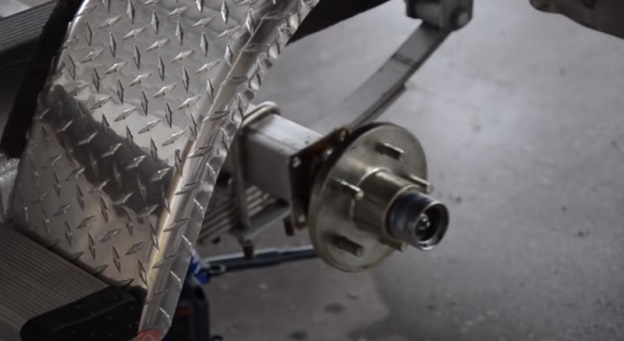
Because trailer axles support and align spindles, they are important for keeping your trailer’s wheels and hubs (and your entire vehicle) in the same place as they should be.
Unless the trailer is cheaply built or has an independent or torsion suspension, the axles are almost always custom-made to fit the trailer and its intended function.
There is a kind of axle for every trailer, ranging from the straight beam torsion axle used by the bulk of multipurpose trailers to stepped/overlay axles, dropped and gull-wing axles, and torsion style suspension / axles.

Trailer axles can affect a trailer’s towing height, deck height, stability under load, and how the trailer moves behind the towing vehicle. However, this depends on how the 6 lug trailer axle are made and set up.
Unless developed and constructed by a competent company, most 3500 lbs axle designs are a crapshoot. This means you might end up with a weak, underbuilt axle or an overbuilt axle that is far stronger and heavier than you need.
Trailer axles in poor condition or that have not been maintained can be devastating. Axles are the core shafts that allow a wheel or gear to be rotated.
To rotate the wheels, an 7000 lb trailer axle can be linked directly to them. An trailer axle kit can also be fastened to a vehicle, and the vehicle’s wheels can turn around the axle without any movement.
Even in a conventional vehicle, the trailer axles for sale must operate smoothly for the vehicle to move.
When your vehicle’s axles are not properly maintained and built, your trailer’s tires may come off while you are driving. That is the danger you face if you have trailer axles kit on your trailer that have not been examined.
You’re most likely hauling some valuable items if you’re towing a utility trailer or a gooseneck trailer. Consider the possibility of your trailer breaking down in the middle of delivery or on the side of the highway.
It’s a time-consuming operation to unload your goods and jack up your vehicle in the middle of a highway to perhaps repair an trailer axle problem. Replacing the trailer axles. This time-consuming procedure may be avoided altogether by performing routine inspections of your trailer’s axle to ensure that a wheel or two does not come flying off in the direction of onlookers.
Why Trailer Axle Servicing Is Important
Regular trailer maintenance is essential for guaranteeing the longevity of your trailer and ensuring that you can pull your trailer to its destination safely and securely. Before towing, check to see that your trailer and its various components are in safe operating condition. Damaged trailer parts can lead to a loss of control and, in some cases, harm. It is very important to have your trailer checked out after an accident or damage.
You must check, maintain, and service your trailer regularly to ensure it is safe and works well.
An essential point to keep in mind about trailer axle maintenance is that it is not the beam itself that demands most of your attention; rather, it is the components linked to the shaft. Regularly, parts should be looked at for damage or signs of aging. This will help avoid roadside accidents that are linked to safety.
Establishing a regular inspection and maintenance program is beneficial to minimize downtime and repair expenses. Every six to twelve months, trailer axles should be examined for damage. The likelihood of costly breakdowns will be significantly decreased due to this.
Regardless of whether you have utility trailers, dump trailers, goosenecks, or car haulers, you will be transporting freight with them. As we said before, paying attention to your axle, which is an important part of your setup, could save you a lot of money.
When it comes to servicing your trailer’s axles, there are a few things you should keep an eye out for.

Establishing a regular maintenance and inspection program would help decrease downtime and repair costs while also ensuring that cars comply with state and federal laws.
Trailer axles should be tested every six to twelve months. The likelihood of costly breakdowns will be significantly decreased as a result.
Tapped Holes and Fasteners: You can replace broken screws and fix damaged threads on tapped holes with the right-sized die.
Brake spider: If cracks are discovered, the axle should be replaced immediately. It is possible to replace the weld on the camshaft retainer if it has been damaged or worn out.
Air chambers and Automatic Slack Adjusters (ASA): The Automatic Slack Adjusters (ASA) recommend avoiding manual modifications in service. Consult the manufacturer’s specs to ensure you’re on the right track. To get optimal braking performance, it is necessary to place the air chamber and ASA at the optimum angle. To determine the pitch, see the manufacturer’s specs.
Camshaft and camshaft bushings: Keep an eye out for camshaft bushing wear and replace them if necessary. Ensure that the whole region of the spline that comes into contact with the ASA is well lubricated. A manufacturer-specified lubricant should be applied to the camshaft bushing following the manufacturer’s instructions.
The primary reason you should repair your trailer axles is to prevent moisture build-up.
Lubrication applied to your axles may become ineffective because of dilution and degradation caused by moisture build-up.
Apart from moisture, dirt, dust, and debris accumulate over time.
Even if your trailer is inactive, a quick clean-up may keep everything functioning smoothly by removing moisture build-up.
A bearing is composed of two components: a cup and a cone. The cup is pushed into the axle’s middle section, while the cone houses the real ball bearings. Bearings should always be thoroughly lubricated to protect them from heat generated by friction.
When inspecting your bearings, properly clean them to remove any build-up.
While wiping out the bearings, inspect for cracks, dents, or any opening that appears to be about to break. If they become damaged, they should be changed as a set with the cup and cone following the trailer’s weight capacity.
If the bearing appears to be in good condition, clean it using a degreaser.
Avoid using an excessive amount of lubrication since this might cause damage to the grease seal.

https://bit.ly/3BDemh6
Rubber seals should be flexible and capable of restraining any fluid. Greasing your bearings excessively might result in seal deterioration. If the seals get broken, grease or oil may begin to seep out, and if the seal is opened, dirt and debris may enter.
When fluid and grime mix, a foul brown material forms that can fully block your bearings, resulting in catastrophic failure. Inspect the seal for any defects and replace it if you see any cracks.
The race is the bearing’s design. Outer and inner races, or bulges, are present on the bearing. Each race is a disk with a groove in the center in which a set of balls is laid. The balls are intended to move freely within the track.
Examine the race with your hands for indications of damage. Any discoloration might result in an incorrect fit and noise during sudden acceleration. Note the trailer axle part number for convenient reference when ordering a replacement if you discover a problem. If everything appears to be in order, pack the bearings by lightly greasing them. Lube the trailer axle as well, and then reinstall the bearing in the center of the axle and secure the nut. Tighten thoroughly since loose nuts might still cause the tires to fall off completely.
Most of your trailer axle troubles are caused by not regularly lubricating your bearings.
Greasing acts as a barrier to the heat generated by friction. Ungreased hubs can overheat, destroying spindles and braking hubs and causing your tires to run off the axle while you drive.
Lube the hub once every year or after 3000 miles if your trailer is often used for goods. Before beginning a standard maintenance procedure, check if your hubs are leaking or your tires bounce. This is easily identified by inspecting the back of the rim for grease spatter.
If the grease is dark or grey, it indicates that there has been a leak and that water, dust, and debris have entered the bearing.
Maintaining the trailer hub has a direct effect on the trailer’s axle. After removing the hub, gently shake or tap it to remove any dust.
To remove the hub from the spindle, unscrew the key lock. Wipe the spindle clean with a lint-free cloth. Examine the spindle for cracks. If the fractures are deep enough, the trailer’s axle needs to be replaced.
Load the bearings with oil when you’re ready to reassemble the seal and ball bearing.
Take a bit of grease in your palm and roll it around the bearing to coat it completely. The bearing cap should be carefully oiled when reinstalling the seal and bearing.
The importance of having a solid trailer axle has been expanded upon in the article. In conclusion, these immediate and easy steps are what you should consider if you are thinking of servicing your trailer axle yourself; Take off the wheel, Remove the bearing cap, Free the hub, Remove the bearings, Check parts for wear, Clean, pack bearings, Start the assembly, Install the hub, Tighten the wheel, and Finish up.
Our trailer parts expert will answer your inquiries within 12 hours.

Tow-Max is a trusted supplier of trailer parts in China, known for its huge variety of products and one-stop services. We have been supplying customers from Australia, South America, the USA, and the Middle East. Our business partners are located in Sydney, Melbourne, Adelaide, Mexico City, Dubai, etc.
No.163-1, Shang yang Road, Dongqian Lake Industrial Zone, Ningbo, 315121, Zhejiang, China
+86-574-8786-2718
+86-574-8786-2717
sales(at)soaringtrailerparts.com
©Copyright 2020. Tow-Max. All rights reserved. Powered by MML.